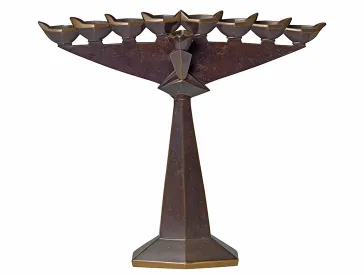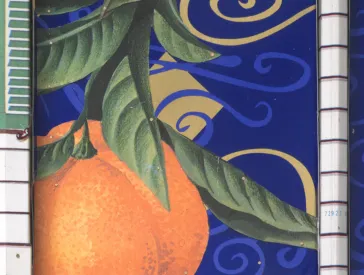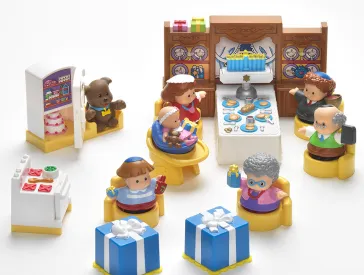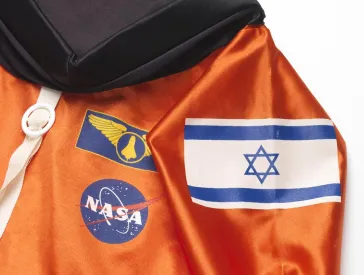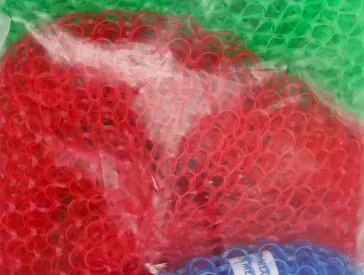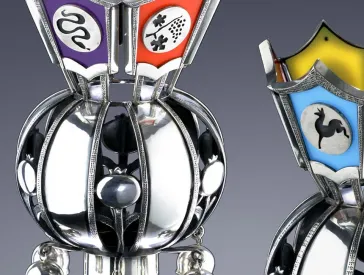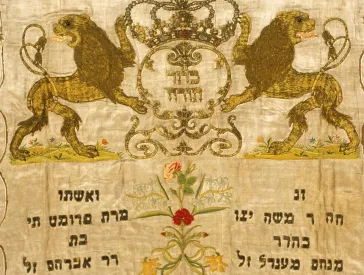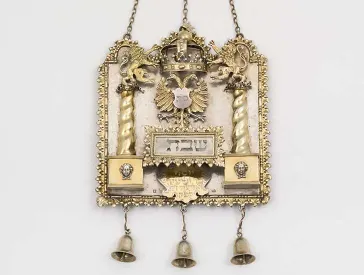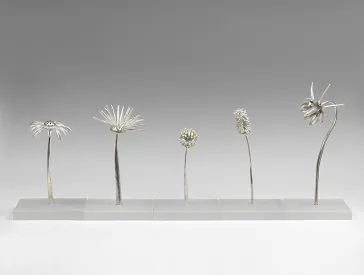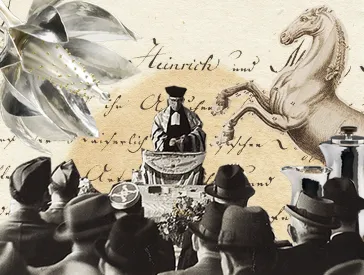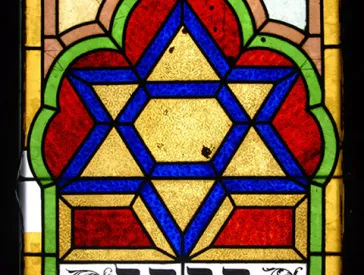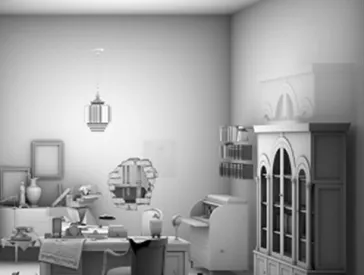Testimonial to
a Family
Torah shield (Tas) and box, Kitzingen, 1711/12, purchased in 2014
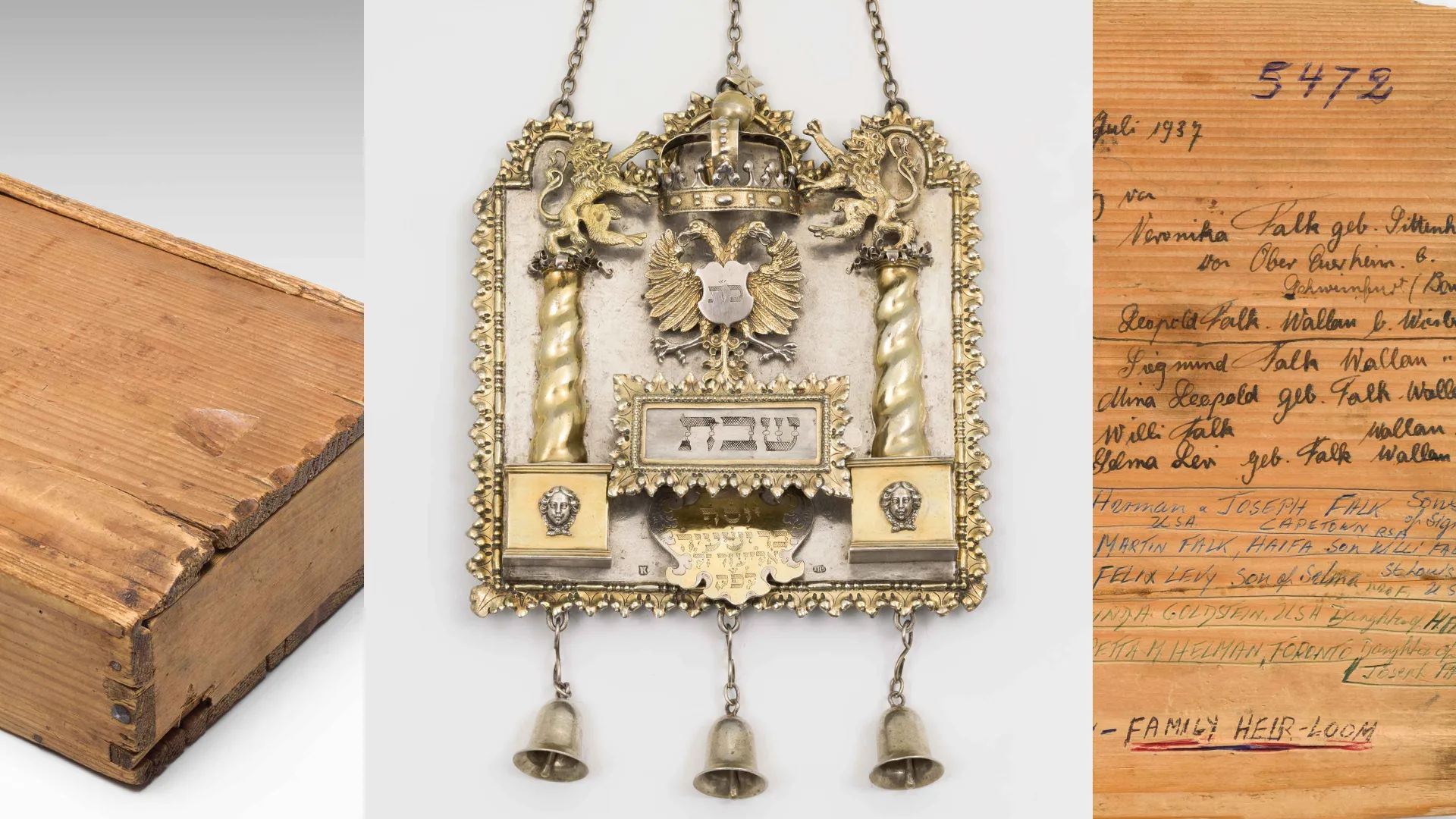
Wooden box, Torah shield and interior side of box lid; Jewish Museum Berlin, photo: Roman März
Buying German-Jewish ceremonial objects is a tricky business. There is little to buy that is made in Germany today and any piece that was created prior to the 1930s, must be viewed with suspicion.
Jewish homes and communities in Germany were ransacked and looted during the National Socialist period and the material was destroyed or dispersed, meaning that objects that appear on the public market may be stolen property. Sellers today can rarely document an unbroken historical chain of ownership.
The buyer therefore has the moral responsibility to try and research the background of the piece, which is often very hard to do in the fast run up to an auction. Unless the piece was previously published, is embellished with a name, or has some other clues, it is incredibly difficult to establish previous ownership. Quite apart from this question of provenance, rare ceremonial items can fetch high figure sums and the buoyancy of the high-end market has led to the proliferation of fakes, which keep improving in their level of sophistication.
Sitting in the back of a closet in Toronto
Due to the history of persecution of German Jews and that fact that Jews taking flight from Germany in the 1930s were often unable to take valuable possessions with them, it is extremely rare to find a genuine Jewish ceremonial object that has remained in a German family for generations. We were therefore tremendously excited when we were approached by Loretta Falk Helman. She told us about a rare, eighteenth century, silver Torah shield that had always been in family hands and had traveled with them along their migratory path. Not only did this magnificent shield have provenance, it was still kept in its original box! When I asked her for its current location, she told me that it was sitting in the back of her closet in Toronto.
Here is Loretta’s story, in her own words:
“This original Torah shield box was inscribed by Sigmund Falk, my grandfather, before fleeing Germany. He recorded the heirs. Veronika (Sittenheim) brought the Torah shield into the Falk family upon her marriage. My father Joseph added his brother, cousins, myself and my three sons, Garron, Wayne and Anton Helman. Jewish family and ancestry were central to my father’s identity. He treasured this heirloom. In his memoirs, he recalls picking up the box from his grandfather every Shabbat and taking it to the Wallau synagogue for services when he was a child. The box travelled with my grandfather via the USA to Cape Town in 1952, was given to my father, and then with my father from Cape Town to Toronto in 1978. The Torah shield was shown to anyone interested in seeing it and hearing the story.
When my father became quite aged, he tasked me, his only child, to care for the Torah shield in its box. Its history mirrors the Falk family’s journey over five generations.”
Loretta Falk Helman unpacks the Torah shield upon its arrival in Berlin; Jewish Museum Berlin, photo: Anna-Carolin Augustin
Preserving and Sharing the Falk Family History
The Jewish Museum Berlin was fortunate to be able to purchase the Torah shield and box for our collections and so they have returned to Germany, after their travels around the globe. Loretta Helman also donated family papers to our Archives. The museum is therefore able to preserve and share the Falk family history that is so closely associated with the piece.
A Rare and Beautiful Piece of German Judaica
The Torah shield itself is a rare and beautiful piece of German Judaica. In Ashkenazic communities, Torah scrolls are generally housed in a Torah ark which is located in the sanctuary of a synagogue building. The scroll is dressed with a decorative mantle, a Torah pointer (to guide the reader when reading from the scroll) and a Torah shield, a decorative breastplate. This Torah shield is inscribed with the Jewish year 5472, corresponding to 1711/12 in the Gregorian calendar. In the early eighteenth century, Jews were still excluded as members of guilds and so their ceremonial silver was necessarily commissioned from non-Jewish gold and silversmiths. German Torah shields at that time tended to have regional stylistic differences and local similarities. This shield was made in Kitzingen, Bavaria, in the workshop of Johann Heinrich Schneider and belongs to a small group of eighteenth-century shields that were made there.
An historical image of a similar Torah shield, made in Kitzingen; Jewish Museum Franken | Central Archives for the History of the Jewish People, Jerusalem, CAHJP P160-428.
The Jewish Community in Wallau
It is unusual to keep a Torah shield at home, but the Falk Torah shield was the personal property of the family and they brought it regularly to their local synagogue, for ceremonial use. The Jewish community in Wallau was small and the synagogue building was modest. The synagogue was last renovated in 1920/21 and seated forty men and twenty-four women. The community continued to use this beautiful shield until Loretta’s father, Joseph, took it with him when he left Germany in 1936. Other members of the Falk family were unable to leave Germany and were deported and perished. During the November pogrom of 1938, the interior of the Wallau synagogue building was destroyed and any remaining ceremonial objects were dumped onto the Jewish community’s funeral wagon, driven to the local sports field and set on fire.
The Torah shield and its box will continue to be studied and discussed as objects that open up many fields of exploration, but with their clear provenance, they also survive as a testimonial to a family and to the destroyed Jewish community of Wallau.
Michal Friedlander, Curator of Judaica and Applied Arts
Citation recommendation:
Michal Friedlander (2021), Testimonial to
a Family. Torah shield (Tas) and box, Kitzingen, 1711/12, purchased in 2014.
URL: www.jmberlin.de/en/node/8453
Selected Objects: Jewish Object: Judaica Collection (9)

